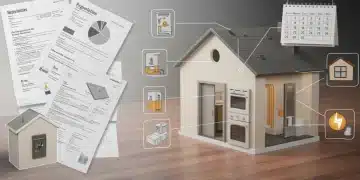Mortgage Interest Deduction 2025: Claim Up to $750,000

Understanding the Mortgage Interest Deduction in 2025 is crucial for homeowners looking to maximize tax savings, allowing claims up to $750,000 in loan interest under current regulations.
Homeowners are currently navigating a complex financial landscape, and understanding the nuances of the mortgage interest deduction in 2025 is paramount for optimizing tax returns. As of the latest updates, the ability to claim up to $750,000 in qualified loan interest remains a significant benefit for many.
Current Landscape of the Mortgage Interest Deduction
The mortgage interest deduction has long been a cornerstone of tax benefits for homeowners in the United States. While its scope was significantly altered by the Tax Cuts and Jobs Act (TCJA) of 2017, the core benefit for many remains intact for 2025. This deduction allows taxpayers to subtract the interest paid on their home mortgage from their taxable income, potentially leading to substantial savings.
The TCJA reduced the limit on deductible mortgage debt from $1 million to $750,000 for new loans taken out after December 15, 2017. For loans originating before this date, the old $1 million limit still applies. This distinction is critical for homeowners to understand as they plan their finances and prepare for the upcoming tax season. The deduction applies to the interest paid on a mortgage used to buy, build, or substantially improve a qualified home, which can include a main home and a second home.
Eligibility Requirements for 2025
To successfully claim the mortgage interest deduction in 2025, homeowners must meet specific criteria set forth by the IRS. These requirements ensure that only qualified interest is deducted, preventing misuse of the tax benefit. Understanding these rules is the first step toward maximizing your tax savings.
Key Eligibility Criteria
- Qualified Residence: The loan must be secured by your main home or a second home. These can include a house, condominium, cooperative, mobile home, boat, or similar property, provided it has sleeping, cooking, and toilet facilities.
- Itemizing Deductions: You must itemize deductions on Schedule A (Form 1040) rather than taking the standard deduction. This is a critical point, as the increased standard deduction under the TCJA means fewer taxpayers itemize.
- Loan Purpose: The mortgage must be used to buy, build, or substantially improve your home. Interest on home equity loans or lines of credit used for other purposes is generally not deductible under the current rules.
It’s important to differentiate between acquisition debt and home equity debt. Acquisition debt is what you use to buy, build, or substantially improve your home. Home equity debt, while also secured by your home, is typically used for other personal expenses, and its interest is not deductible unless it falls under the acquisition debt definition by being used for home improvements.
Understanding the $750,000 Loan Limit
The $750,000 limit on qualified mortgage debt is a central aspect of the current deduction rules. This cap applies to the total amount of mortgage debt on which you can deduct interest, not the amount of interest itself. For married couples filing separately, the limit is $375,000 each. This limit affects loans taken out after December 15, 2017, posing a significant change for recent homebuyers.
Homeowners with existing mortgages predating this date can still deduct interest on up to $1 million in acquisition debt ($500,000 for married couples filing separately). This grandfathering clause is a crucial detail, creating two distinct groups of homeowners regarding the deduction. The limit applies to the combined balance of all mortgages on your main home and second home.
For example, if you purchased your home in 2019 with a $800,000 mortgage, you can only deduct interest on the first $750,000 of that loan. If you refinanced a pre-TCJA loan, the new loan generally retains the original loan’s acquisition date for deduction purposes, up to the amount of the original mortgage principal. Any additional funds borrowed beyond the original principal amount would be subject to the new $750,000 limit, or may not be deductible at all if not used for home improvements.
Calculating Your Deductible Interest
Calculating the exact amount of deductible mortgage interest requires careful attention to detail and access to your mortgage statements. Most lenders provide Form 1098, Mortgage Interest Statement, which reports the amount of interest you paid during the year. This form is your primary document for determining your deduction.

However, simply taking the figure from Form 1098 might not always be sufficient, especially if your mortgage balance exceeds the $750,000 limit or if you have multiple mortgages. In such cases, you may need to perform additional calculations to determine the deductible portion. The IRS provides specific worksheets in Publication 936, Home Mortgage Interest Deduction, to guide taxpayers through these more complex scenarios.
Steps for Calculation
- Review Form 1098: Identify the total interest paid.
- Check Loan Dates and Amounts: Determine if your mortgage is subject to the $750,000 or $1 million limit based on its origination date and amount.
- Prorate Interest if Necessary: If your loan balance exceeds the applicable limit, you’ll need to calculate the deductible portion of the interest. This involves a ratio of the deductible loan amount to the total loan amount.
- Consider Points and PMI: In certain situations, points paid to obtain a mortgage and private mortgage insurance (PMI) premiums may also be deductible, subject to specific rules and limitations.
It’s advisable to consult a tax professional if your situation is complex, such as having multiple mortgages, a home equity line of credit, or if you’re unsure about applying the limits correctly. Accurate calculation is key to avoiding issues with the IRS and ensuring you claim all eligible deductions.
Impact of Refinancing and Home Equity Loans
Refinancing a mortgage or taking out a home equity loan can significantly impact the deductibility of your interest. The rules surrounding these types of loans are particularly nuanced and require careful consideration to avoid inadvertently losing out on valuable tax benefits. Understanding how these actions affect your acquisition debt limit is crucial for effective financial planning.
When you refinance your mortgage, the general rule is that the new loan is treated as acquisition debt up to the amount of the original mortgage principal. If you borrow more than your outstanding principal balance, that additional amount is only considered acquisition debt if it’s used to substantially improve your home. If the extra funds are used for other purposes, the interest on that portion of the loan is not deductible.
Home Equity Loan Considerations
For home equity loans or lines of credit (HELOCs), the interest is only deductible if the funds are used to buy, build, or substantially improve the home securing the loan. For example, if you take out a HELOC to pay for a kitchen renovation, the interest on that portion of the loan would be deductible, provided it doesn’t push your total acquisition debt over the $750,000 limit. However, if you use the HELOC to pay off credit card debt or buy a car, the interest is not deductible.
This distinction is often misunderstood, leading many homeowners to mistakenly believe that all interest on loans secured by their home is deductible. It is essential to keep detailed records of how home equity funds are used to substantiate any deductions claimed. The IRS is vigilant about enforcing these rules, and insufficient documentation can lead to disallowed deductions and potential penalties.
Future Outlook and Potential Changes
The current rules for the mortgage interest deduction, including the $750,000 limit, are set to expire after December 31, 2025, unless Congress acts to extend or modify them. This impending expiration creates uncertainty for homeowners and financial planners looking beyond the immediate tax year. While no immediate changes are anticipated for the 2025 tax year, the legislative landscape could shift dramatically in the coming months.
Discussions around tax reform are a constant in Washington, D.C., and the future of the mortgage interest deduction is often a topic of debate. Policymakers weigh the benefits of encouraging homeownership against the need for revenue and tax simplification. Any changes could affect how much interest homeowners can deduct, the overall limit, or even the existence of the deduction itself.
Homeowners should stay informed about legislative developments and consider how potential changes might impact their financial planning. Consulting with tax advisors who are up-to-date on federal tax policy is crucial for anticipating and adapting to any shifts in the rules. Preparing for various scenarios can help mitigate potential negative impacts and ensure continued optimization of tax benefits.
| Key Point | Brief Description |
|---|---|
| Deduction Limit | Interest on up to $750,000 of qualified mortgage debt is deductible for loans taken after Dec 15, 2017. |
| Eligibility | Must itemize deductions and loan must be for buying, building, or substantially improving a main or second home. |
| Refinancing Impact | New loans retain original acquisition date for deduction up to original principal; additional funds must be for home improvements. |
| Future Changes | Current rules expire after Dec 31, 2025, pending Congressional action, requiring ongoing monitoring. |
Frequently Asked Questions About Mortgage Interest Deduction
For mortgages taken out after December 15, 2017, you can deduct interest on up to $750,000 of qualified acquisition debt. For older mortgages, the limit is $1 million. This applies to the combined debt on your main and second home.
Yes, to deduct mortgage interest, you must itemize your deductions on Schedule A (Form 1040). If your total itemized deductions are less than the standard deduction, it may be more beneficial to take the standard deduction.
Interest on a HELOC is only deductible if the funds are used to buy, build, or substantially improve the home securing the loan. If used for other purposes, like paying off credit card debt, the interest is generally not deductible.
You typically need Form 1098, Mortgage Interest Statement, provided by your lender, which shows the total interest paid. Keep records of loan agreements and proof of how loan funds were used, especially for home equity loans.
The current rules, including the $750,000 limit, are set to expire after December 31, 2025. Congress could extend or modify them. Homeowners should monitor legislative developments and consult tax professionals for updates.
What Happens Next – Navigating the Future of Mortgage Tax Benefits
As the 2025 tax year approaches, homeowners face an increasingly complex environment when it comes to managing deductions and optimizing financial strategies. The mortgage interest deduction, one of the most substantial tax benefits available to property owners, remains a central focus of fiscal policy discussions in Washington. Although current provisions under the Tax Cuts and Jobs Act (TCJA) are still in effect, ongoing debates about housing affordability, tax equity, and federal revenue priorities suggest that potential revisions could reshape how this deduction functions in the coming years.
Financial advisors are emphasizing the importance of preparation and documentation. Homeowners should conduct a thorough review of their mortgage balance, interest payments, and itemized deductions, especially those approaching the $750,000 loan cap or considering refinancing. Guidance from trusted sources such as NerdWallet’s mortgage interest deduction overview can help clarify eligibility criteria, deduction limits, and filing best practices under current IRS rules. Understanding these details now can prevent costly surprises later and ensure that taxpayers are positioned to capture the maximum allowable benefits.
Looking ahead, any legislative updates—whether extending, phasing out, or modifying the deduction—will likely have ripple effects across the housing market. Real estate values, borrowing behavior, and refinancing activity could all shift in response to policy changes. Proactive homeowners who align their financial plans with evolving tax frameworks will be better equipped to safeguard their equity and reduce tax liabilities.
Ultimately, the coming years will reward those who pair financial literacy with strategic foresight. By staying informed, consulting professionals, and monitoring official IRS updates, homeowners can navigate uncertainty with confidence—ensuring that their mortgage remains not just a long-term investment in property, but also a powerful tool for tax-efficient wealth management.





